Research Progress in Fluorescent Probes for Arsenic Species
Abstract
1. Introduction
2. Nanomaterial Based Probes
2.1. Functionalized Gold Nanoparticles
2.2. Carbon Dots
2.3. Quantum Dots
2.4. Other Types of Nanosensors
3. Organic Molecule-Based Probes
3.1. Small Organic Molecules
3.2. Organic Frameworks
4. Biomolecule and Cell-Based Probes
4.1. Peptide/Proteins
4.2. Aptamers
4.3. Bacteria
5. Conclusions and Future Perspectives
Author Contributions
Funding
Institutional Review Board Statement
Informed Consent Statement
Data Availability Statement
Conflicts of Interest
References
- Lew, T.T.S.; Park, M.; Cui, J.; Strano, M.S. Plant nanobionic sensors for arsenic detection. Adv. Mater. 2021, 33, 2005683. [Google Scholar] [CrossRef]
- Mays, D.E.; Hussam, A. Voltammetric methods for determination and speciation of inorganic arsenic in the environment—A review. Anal. Chim. Acta 2009, 646, 6–16. [Google Scholar] [CrossRef]
- Mohammadi, S.; Mohammadi, S.; Salimi, A.; Ahmadi, R. A Chelation-enhanced fluorescence assay using thiourea capped carbonaceous fluorescent nanoparticles for As (III) detection in water samples. J. Fluoresc. 2022, 32, 145–153. [Google Scholar] [CrossRef] [PubMed]
- Smedley, P.L.; Kinniburgh, D.G. A review of the source, behaviour and distribution of arsenic in natural waters. Appl. Geochem. 2002, 17, 517–568. [Google Scholar] [CrossRef]
- Tewatia, P.; Kumar, V.; Samota, S.; Singhal, S.; Kaushik, A. Sensing and annihilation of ultra-trace level arsenic (III) using fluoranthene decorated fluorescent nanofibrous cellulose probe. J. Hazard. Mater. 2022, 424, 127722. [Google Scholar] [CrossRef] [PubMed]
- Jaishankar, M.; Tseten, T.; Anbalagan, N.; Mathew, B.B.; Beeregowda, K.N. Toxicity, mechanism and health effects of some heavy metals. Interdiscip. Toxicol. 2014, 7, 60–72. [Google Scholar] [CrossRef]
- Podgorski, J.; Berg, M. Global threat of arsenic in groundwater. Science 2020, 368, 845–850. [Google Scholar] [CrossRef]
- Yadav, N.; Singh, A.K. Dual anion colorimetric and fluorometric sensing of arsenite and cyanide ions. RSC Adv. 2016, 6, 100136–100144. [Google Scholar] [CrossRef]
- Moghimi, N.; Mohapatra, M.; Leung, K.T. Bimetallic nanoparticles for arsenic detection. Anal. Chem. 2015, 87, 5546–5552. [Google Scholar] [CrossRef]
- Lee, D.-H.; Lee, D.-N.; Hong, J.-I. A fluorescent probe for a lewisite simulant. New J. Chem. 2016, 40, 9021–9024. [Google Scholar] [CrossRef]
- Richardson, S.D.; Ternes, T.A. Water analysis: Emerging contaminants and current issues. Anal. Chem. 2018, 90, 398–428. [Google Scholar] [CrossRef]
- Zhang, Q.; Minami, H.; Inoue, S.; Atsuya, I. Differential determination of trace amounts of arsenic (III) and arsenic (V) in seawater by solid sampling atomic absorption spectrometry after preconcentration by coprecipitation with a nickel–pyrrolidine dithiocarbamate complex. Anal. Chim. Acta 2004, 508, 99–105. [Google Scholar] [CrossRef]
- Hung, D.Q.; Nekrassova, O.; Compton, R.G. Analytical methods for inorganic arsenic in water: A review. Talanta 2004, 64, 269–277. [Google Scholar] [CrossRef]
- Mao, X.; Qi, Y.; Huang, J.; Liu, J.; Chen, G.; Na, X.; Wang, M.; Qian, Y. Ambient-temperature trap/release of arsenic by dielectric barrier discharge and its application to ultratrace arsenic determination in surface water followed by atomic fluorescence spectrometry. Anal. Chem. 2016, 88, 4147–4152. [Google Scholar] [CrossRef]
- Colon, M.; Hidalgo, M.; Iglesias, M. Arsenic determination by ICP-QMS with octopole collision/reaction cell. Overcome of matrix effects under vented and pressurized cell conditions. Talanta 2011, 85, 1941–1947. [Google Scholar] [CrossRef]
- Diesel, E.; Schreiber, M.; Meer, J.R.v.d. Development of bacteria-based bioassays for arsenic detection in natural waters. Anal. Bioanal. Chem. 2009, 394, 687–693. [Google Scholar] [CrossRef]
- Wu, C.-J.; Li, X.-Y.; Zhu, T.; Zhao, M.; Song, Z.; Li, S.; Shan, G.-G.; Niu, G. Exploiting the twisted intramolecular charge transfer effect to construct a wash-free solvatochromic fluorescent lipid droplet probe for fatty liver disease diagnosis. Anal. Chem. 2022, 94, 3881–3887. [Google Scholar] [CrossRef] [PubMed]
- Cao, M.; Zhu, T.; Zhao, M.; Meng, F.; Liu, Z.; Wang, J.; Niu, G.; Yu, X. Structure rigidification promoted ultrabright solvatochromic fluorescent probes for super-resolution imaging of cytosolic and nuclear lipid droplets. Anal. Chem. 2022, 94, 10676–10684. [Google Scholar] [CrossRef] [PubMed]
- Siddiki, M.S.R.; Shimoaoki, S.; Ueda, S.; Maeda, I. Thermoresponsive magnetic nano-biosensors for rapid measurements of inorganic arsenic and cadmium. Sensors 2012, 12, 14041–14052. [Google Scholar] [CrossRef]
- Banik, D.; Manna, S.K.; Mahapatra, A.K. Recent development of chromogenic and fluorogenic chemosensors for the detection of arsenic species: Environmental and biological applications. Spectrochim. Acta A 2021, 246, 119047. [Google Scholar] [CrossRef] [PubMed]
- Samanta, T.; Shunmugam, R. Colorimetric and fluorometric probes for the optical detection of environmental Hg(II) and As(III) ions. Mater. Adv. 2021, 2, 64–95. [Google Scholar] [CrossRef]
- Zhang, L.; Chen, X.-R.; Wen, S.-H.; Liang, R.-P.; Qiu, J.-D. Optical sensors for inorganic arsenic detection. TrAC Trends Anal. Chem. 2019, 118, 869–879. [Google Scholar] [CrossRef]
- Xu, X.; Niu, X.; Li, X.; Li, Z.; Du, D.; Lin, Y. Nanomaterial-based sensors and biosensors for enhanced inorganic arsenic detection: A functional perspective. Sens. Actuators B Chem. 2020, 315, 128100. [Google Scholar] [CrossRef]
- Roy, S.; Palui, G.; Banerjee, A. The as-prepared gold cluster-based fluorescent sensor for the selective detection of AsIII ions in aqueous solution. Nanoscale 2012, 4, 2734–2740. [Google Scholar] [CrossRef] [PubMed]
- Babu, P.J.; Doble, M. Albumin capped carbon-gold (C-Au) nanocomposite as an optical sensor for the detection of arsenic(III). Opt. Mater. 2018, 84, 339–344. [Google Scholar] [CrossRef]
- Ge, K.; Liu, J.; Wang, P.; Fang, G.; Zhang, D.; Wang, S. Near-infrared-emitting persistent luminescent nanoparticles modified with gold nanorods as multifunctional probes for detection of arsenic(III). Microchim. Acta 2019, 186, 197. [Google Scholar] [CrossRef] [PubMed]
- Gupta, A.; Verma, N.C.; Khan, S.; Nandi, C.K. Carbon dots for naked eye colorimetric ultrasensitive arsenic and glutathione detection. Biosens. Bioelectron. 2016, 81, 465–472. [Google Scholar] [CrossRef]
- Radhakrishnan, K.; Panneerselvam, P. Green synthesis of surface-passivated carbon dots from the prickly pear cactus as a fluorescent probe for the dual detection of arsenic(III) and hypochlorite ions from drinking water. RSC Adv. 2018, 8, 30455–30467. [Google Scholar] [CrossRef] [PubMed]
- Rajendran, S.; Ramanaiah, D.V.; Kundu, S.; Bhunia, S.K. Yellow fluorescent carbon dots for selective recognition of As3+ and Fe3+ ions. ACS Appl. Nano Mater. 2021, 4, 10931–10942. [Google Scholar] [CrossRef]
- Boxi, S.S.; Paria, S. Fluorometric sensing of ultralow As(III) concentrations using Ag doped hollow CdS/ZnS bi-layer nanoparticles. Dalton Trans. 2015, 44, 20464–20474. [Google Scholar] [CrossRef]
- Wen, S.-H.; Liang, R.-P.; Zeng, H.-H.; Zhang, L.; Qiu, J.-D. CdSe/ZnS quantum dots coated with carboxy-PEG and modified with the terbium(III) complex of guanosine 5′-monophosphate as a fluorescent nanoprobe for ratiometric determination of arsenate via its inhibition of acid phosphatase activity. Microchim. Acta 2019, 186, 45. [Google Scholar] [CrossRef] [PubMed]
- Thepmanee, O.; Prapainop, P.; Noppha, O.; Rattanawimanwong, N.; Siangproh, W.; Chailapakul, O.; Songsrirote, K. A simple paper-based approach for arsenic determination in water using hydride generation coupled with mercaptosuccinic-acid capped CdTe quantum dots. Anal. Methods 2020, 12, 2718–2726. [Google Scholar] [CrossRef] [PubMed]
- Soni, G.K.; Wangoo, N.; Cokca, C.; Peneva, K.; Sharma, R.K. Ultrasensitive aptasensor for arsenic detection using quantum dots and guanylated Poly(methacrylamide). Anal. Chim. Acta 2022, 1209, 339854. [Google Scholar] [CrossRef]
- Rahimi, F.; Anbia, M.; Farahi, M. Aqueous synthesis of L- methionine capped PbS quantum dots for sensitive detection and quantification of arsenic (III). J. Photochem. Photobiol. A Chem. 2021, 417, 113361. [Google Scholar] [CrossRef]
- Liu, Z.; Li, G.; Xia, T.; Su, X. Ultrasensitive fluorescent nanosensor for arsenate assay and removal using oligonucleotide-functionalized CuInS2 quantum dot@magnetic Fe3O4 nanoparticles composite. Sens. Actuators B Chem. 2015, 220, 1205–1211. [Google Scholar] [CrossRef]
- Zhang, L.; Cheng, X.-Z.; Kuang, L.; Xu, A.-Z.; Liang, R.-P.; Qiu, J.-D. Simple and highly selective detection of arsenite based on the assembly-induced fluorescence enhancement of DNA quantum dots. Biosens. Bioelectron. 2017, 94, 701–706. [Google Scholar] [CrossRef]
- Pathan, S.; Jalal, M.; Prasad, S.; Bose, S. Aggregation-induced enhanced photoluminescence in magnetic graphene oxide quantum dots as a fluorescence probe for As(III) sensing. J. Mater. Chem. A 2019, 7, 8510–8520. [Google Scholar] [CrossRef]
- Yang, J.-L.; Li, Y.-J.; Yuan, Y.-H.; Liang, R.-P.; Qiu, J.-D. Target induced aggregation of Ce(III)-based coordination polymer nanoparticles for fluorimetric detection of As(III). Talanta 2018, 190, 255–262. [Google Scholar] [CrossRef]
- Ravikumar, A.; Panneerselvam, P.; Radhakrishnan, K.; Christus, A.A.B.; Sivanesan, S. MoS2 nanosheets as an effective fluorescent quencher for successive detection of arsenic ions in aqueous system. Appl. Surf. Sci. 2018, 449, 31–38. [Google Scholar] [CrossRef]
- Geng, R.; Li, P.; Tang, H.; Liu, L.; Huang, H.; Feng, W.; Zhang, Z. Bimetallic Cd/Zr-UiO-66 material as a turn-on/off probe for As5+/Fe3+ in organic media. Chemosphere 2022, 291, 132827. [Google Scholar] [CrossRef]
- Yuan, M.; Wang, M.-X.; Zheng, Y.-Z.; Cao, H.; Xu, F.; Ye, T.; Yu, J.-S. Aptamer/gold nanoparticles-based fluorometric and colorimetric dual-mode detection of arsenite. Chin. J. Anal. Chem. 2021, 49, 76–84. [Google Scholar] [CrossRef]
- Saikia, A.; Karak, N. Polyaniline nanofiber/carbon dot nanohybrid as an efficient fluorimetric sensor for As (III) in water and effective antioxidant. Mater. Today Commun. 2018, 14, 82–89. [Google Scholar] [CrossRef]
- Pooja, D.; Saini, S.; Thakur, A.; Kumar, B.; Tyagi, S.; Nayak, M.K. A “Turn-On” thiol functionalized fluorescent carbon quantum dot based chemosensory system for arsenite detection. J. Hazard. Mater. 2017, 328, 117–126. [Google Scholar] [CrossRef]
- Li, J.; Yang, L.; Ruan, Y.; Chu, S.; Wang, H.; Li, Z.; Jiang, C.; Liu, B.; Yang, L.; Zhang, Z. Dual-mode optical nanosensor based on gold nanoparticles and carbon dots for visible detection of As(III) in water. ACS Appl. Nano Mater. 2020, 3, 8224–8231. [Google Scholar] [CrossRef]
- Sun, Q.; Yang, L.; Su, L.; Liu, W.; Wang, Y.; Yu, S.; Jiang, C.; Zhang, Z. Colloidal quantum dot chains: Self-assembly mechanism and ratiometric fluorescent sensing. RSC Adv. 2017, 7, 53977–53983. [Google Scholar] [CrossRef]
- Pal, S.K.; Akhtar, N.; Ghosh, S.K. Determination of arsenic in water using fluorescent ZnO quantum dots. Anal. Methods 2016, 8, 445–452. [Google Scholar] [CrossRef]
- Kayal, S.; Halder, M. A ZnS quantum dot-based super selective fluorescent chemosensor for soluble ppb-level total arsenic [As(III) + As(V)] in aqueous media: Direct assay utilizing aggregation-enhanced emission (AEE) for analytical application. Analyst 2019, 144, 3710–3715. [Google Scholar] [CrossRef]
- Zhou, Y.; Huang, X.; Liu, C.; Zhang, R.; Gu, X.; Guan, G.; Jiang, C.; Zhang, L.; Du, S.; Liu, B.; et al. Color-Multiplexing-Based Fluorescent Test Paper: Dosage-Sensitive Visualization of arsenic(III) with Discernable Scale as Low as 5 ppb. Anal. Chem. 2016, 88, 6105–6109. [Google Scholar] [CrossRef] [PubMed]
- Dwivedi, A.; Srivastava, M.; Upadhyay, R.; Srivastava, A.; Yadav, R.S.; Srivastava, S.K. A flexible Eu:Y2O3-polyvinyl alcohol photoluminescent film for sensitive and rapid detection of arsenic ions. Microchem. J. 2022, 172, 106969. [Google Scholar] [CrossRef]
- Duhan, S.; Sahoo, K.; Singh, S.K.; Kumar, M. Development of ultrasensitive and As(III)-selective upconverting (NaYF4:Yb3+,Er3+) platform. Analyst 2020, 145, 6378–6387. [Google Scholar] [CrossRef] [PubMed]
- Xu, J.; Liu, R.; Li, H.; Chen, Q. Multifunctional upconversion nanoparticles based LRET aptasensor for specific detection of As(III) in aquatic products. Sens. Actuators B Chem. 2022, 369, 132271. [Google Scholar] [CrossRef]
- Cheng, Y.; Wang, S.; Zhang, J.; Cao, J.; Qu, Y. A fluorescent molecular sensor based on ESIPT process for rapid detection of arsenic species in hydrophobic system. J. Mol. Struct. 2020, 1221, 128824. [Google Scholar] [CrossRef]
- Biswas, S.; Chowdhury, T.; Ghosh, A.; Das, A.K.; Das, D. Effect of O-substitution in imidazole based Zn(II) dual fluorescent probes in the light of arsenate detection in potable water: A combined experimental and theoretical approach. Dalton Trans. 2022, 51, 7174–7187. [Google Scholar] [CrossRef]
- Ezeh, V.C.; Harrop, T.C. A sensitive and selective fluorescence sensor for the detection of arsenic(III) in organic media. Inorg. Chem. 2012, 51, 1213–1215. [Google Scholar] [CrossRef]
- Ezeh, V.C.; Harrop, T.C. Synthesis and properties of arsenic(III)-reactive coumarin-appended benzothiazolines: A new approach for inorganic arsenic detection. Inorg. Chem. 2013, 52, 2323–2334. [Google Scholar] [CrossRef]
- Song, R.; Ma, Y.; Bi, A.; Feng, B.; Huang, L.; Huang, S.; Huang, X.; Yin, D.; Chen, F.; Zeng, W. Highly selective and sensitive detection of arsenite ions(III) using a novel tetraphenylimidazole-based probe. Anal. Methods 2021, 13, 5011–5016. [Google Scholar] [CrossRef] [PubMed]
- Dey, S.; Kumar, A.; Mondal, P.K.; Modi, K.M.; Chopra, D.; Jain, V.K. An oxacalix [4]arene derived dual sensing fluorescent probe for the detection of As(V) and Cr(VI) oxyanions in aqueous media. Dalton Trans. 2020, 49, 7459–7466. [Google Scholar] [CrossRef]
- Aatif, A.M.; Kumar, S.K.A. Dual anion colorimetric and fluorometric sensing of arsenite and cyanide ions involving MLCT and CHEF pathways. J. Mol. Struct. 2022, 1250, 131677. [Google Scholar] [CrossRef]
- Deepa, A.; Padmini, V. Highly efficient colorimetric sensor for selective and sensitive detection of arsenite ion (III) in aqueous medium. J. Fluoresc. 2019, 29, 813–818. [Google Scholar] [CrossRef]
- Murugan, A.S.; Vidhyalakshmi, N.; Ramesh, U.; Annaraj, J. In vivo bio-imaging of sodium meta-arsenite and hydrogen phosphate in zebrafish embryos using red fluorescent zinc complex. Sens. Actuators B Chem. 2019, 281, 507–513. [Google Scholar] [CrossRef]
- Paul, S.; Bhuyan, S.; Mukhopadhyay, S.K.; Murmu, N.C.; Banerjee, P. Sensitive and selective in vitro recognition of biologically toxic As(III) by rhodamine based chemoreceptor. ACS Sustainable Chem. Eng. 2019, 7, 13687–13697. [Google Scholar] [CrossRef]
- Kreno, L.E.; Leong, K.; Farha, O.K.; Allendorf, M.; Duyne, R.P.V.; Hupp, J.T. Metal-organic framework materials as chemical sensors. Chem. Rev. 2012, 112, 1105–1125. [Google Scholar] [CrossRef] [PubMed]
- Allendorf, M.D.; Bauer, C.A.; Bhakta, R.K.; Houk, R.J.T. Luminescent metal–organic frameworks. Chem. Soc. Rev. 2009, 38, 1330–1352. [Google Scholar] [CrossRef] [PubMed]
- Li, J.; Wang, X.; Zhao, G.; Chen, C.; Chai, Z.; Alsaedi, A.; Hayat, T.; Wang, X. Metal–organic framework-based materials: Superior adsorbents for the capture of toxic and radioactive metal ions. Chem. Soc. Rev. 2018, 47, 2322–2356. [Google Scholar] [CrossRef]
- Wang, X.; Zhang, L.; Yang, J.; Liu, F.; Dai, F.; Wang, R.; Sun, D. Lanthanide metal–organic frameworks containing a novel flexible ligand for luminescence sensing of small organic molecules and selective adsorption. J. Mater. Chem. A 2015, 3, 12777–12785. [Google Scholar] [CrossRef]
- Karmakar, A.; Joarder, B.; Mallick, A.; Samanta, P.; Desai, A.V.; Basu, S.; Ghosh, S.K. Aqueous phase sensing of cyanide ions using a hydrolytically stable metal–organic framework. Chem. Commun. 2017, 53, 1253–1256. [Google Scholar] [CrossRef]
- Dutta, S.; Let, S.; Shirolkar, M.M.; Desai, A.V.; Samanta, P.; Fajal, S.; More, Y.D.; Ghosh, S.K. A luminescent cationic MOF for bimodal recognition of chromium and arsenic based oxo-anions in water. Dalton Trans. 2021, 50, 10133–10141. [Google Scholar] [CrossRef]
- Xu, X.; Luo, Z.; Ye, K.; Zou, X.; Niu, X.; Pan, J. One-pot construction of acid phosphatase and hemin loaded multifunctional metal–organic framework nanosheets for ratiometric fluorescent arsenate sensing. J. Hazard. Mater. 2021, 412, 124407. [Google Scholar] [CrossRef]
- Liu, S.; Liu, M.; Guo, M.; Wang, Z.; Wang, X.; Cui, W.; Tian, Z. Development of Eu-based metal-organic frameworks (MOFs) for luminescence sensing and entrapping of arsenate ion. J. Lumin. 2021, 236, 118102. [Google Scholar] [CrossRef]
- Muppidathi, M.; Perumal, P.; Ayyanu, R.; Subramanian, S. Immobilization of ssDNA on a metal–organic framework derived magnetic porous carbon (MPC) composite as a fluorescent sensing platform for the detection of arsenate ions. Analyst 2019, 144, 3111–3118. [Google Scholar] [CrossRef]
- Das, G.; Biswal, B.P.; Kandambeth, S.; Venkatesh, V.; Kaur, G.; Addicoat, M.; Heine, T.; Verma, S.; Banerjee, R. Chemical sensing in two dimensional porous covalent organic nanosheets. Chem. Sci. 2015, 6, 3931–3939. [Google Scholar] [CrossRef] [PubMed]
- Yin, Y.; Liu, G. A covalent organic framework containing bipyridine groups as a fluorescent chemical probe for the ultrasensitive detection of arsenic (III). J. Photochem. Photobiol. A Chem. 2021, 421, 113528. [Google Scholar] [CrossRef]
- Chen, H.; Liu, W.; Cheng, L.; Meledina, M.; Meledin, A.; Deun, R.V.; Leus, K.; Voort, P.V.D. Amidoxime-functionalized covalent organic framework as simultaneous luminescent sensor and adsorbent for organic arsenic from water. Chem. Eng. J. 2022, 429, 132162. [Google Scholar] [CrossRef]
- Chen, B.; Liu, Q.; Popowich, A.; Shen, S.; Yan, X.; Zhang, Q.; Li, X.-F.; Weinfeld, M.; Cullen, W.R.; Le, X.C. Therapeutic and analytical applications of arsenic binding to proteins. Metallomics 2015, 7, 39–55. [Google Scholar] [CrossRef] [PubMed]
- Porter, S.E.G.; Barber, A.E.; Colella, O.K.; Roach, T.D. Using biological organisms as chemical sensors: The MicRoboCop project. J. Chem. Educ. 2018, 95, 1392–1397. [Google Scholar] [CrossRef]
- Manap, M.R.A.; Yusof, N.A.; Nor, S.M.M.; Ahmad, F.B.H. Spectrofluorimetric determination of arsenic(III) using dansylated peptide. Asian J. Chem. 2013, 25, 4195–4198. [Google Scholar] [CrossRef]
- Turner, K.; Joel, S.; Feliciano, J.; Feltus, A.; Pasini, P.; Wynn, D.; Dau, P.; Dikici, E.; Deo, S.K.; Daunert, S. Transcriptional regulatory proteins as biosensing tools. Chem. Commun. 2017, 53, 6820–6823. [Google Scholar] [CrossRef]
- Hao, Z.; Zhu, R.; Chen, P.R. Genetically encoded fluorescent sensors for measuring transition and heavy metals in biological systems. Curr. Opin. Chem. Biol. 2018, 43, 87–96. [Google Scholar] [CrossRef]
- Ravikumar, Y.; Nadarajan, S.P.; Lee, C.-S.; Yun, H. Engineering an FMN-based iLOV protein for the detection of arsenic ions. Anal. Biochem. 2017, 525, 38–43. [Google Scholar] [CrossRef]
- Taghdisi, S.M.; Danesh, N.M.; Ramezani, M.; Emrani, A.S.; Abnous, K. A simple and rapid fluorescent aptasensor for ultrasensitive detection of arsenic based on target-induced conformational change of complementary strand of aptamer and silica nanoparticles. Sens. Actuators B Chem. 2018, 256, 472–478. [Google Scholar] [CrossRef]
- Pan, J.; Li, Q.; Zhou, D.; Chen, J. Ultrasensitive aptamer biosensor for arsenic (III) detection based on label-free triple-helix molecular switch and fluorescence sensing platform. Talanta 2018, 189, 370–376. [Google Scholar] [CrossRef] [PubMed]
- Zeng, L.; Zhou, D.; Gong, J.; Liu, C.; Chen, J. Highly sensitive aptasensor for trace arsenic(III) detection using DNAzyme as the biocatalytic amplifier. Anal. Chem. 2019, 91, 1724–1727. [Google Scholar] [CrossRef] [PubMed]
- Pola-López, L.A.; Camas-Anzueto, J.L.; Martínez-Antonio, A.; Luján-Hidalgo, M.C.; Anzueto-Sánchez, G.; Ruíz-Valdiviezo, V.M.; Grajales-Coutiño, R.; González, J.H.C. Novel arsenic biosensor “POLA” obtained by a genetically modified E. coli bioreporter cell. Sens. Actuators B Chem. 2018, 254, 1061–1068. [Google Scholar] [CrossRef]
- Pothier, M.P.; Hinz, A.J.; Poulain, A.J. Insights into arsenite and arsenate uptake pathways using a whole cell biosensor. Front. Microbiol. 2018, 9, 2310. [Google Scholar] [CrossRef]
- Elcin, E.; Öktem, H.A. Immobilization of fluorescent bacterial bioreporter for arsenic detection. J. Environ. Health. Sci. 2020, 18, 137–148. [Google Scholar] [CrossRef]
- Ayuba, R.; Umeno, D.; Kawai-Noma, S. OFF-switching property of quorum sensor LuxR via As(III)-induced insoluble form. J. Biosci. Bioeng. 2022, 133, 335–339. [Google Scholar] [CrossRef]
- Theytaz, T.; Braschler, T.; Lintel, H.v.; Renaud, P.; Diesel, E.; Merulla, D.; Meer, J.v.d. Biochip with E. coli bacteria for detection of arsenic in drinking water. Procedia Chem. 2009, 1, 1003–1006. [Google Scholar] [CrossRef]
- Buff, N.; Merulla, D.; Beutier, J.; Barbaud, F.; Beggah, S.; Lintel, H.v.; Renaud, P.; Meer, J.R.v.d. Development of a microfluidics biosensor for agarose-bead immobilized Escherichia coli bioreporter cells for arsenite detection in aqueous samples. Lab Chip 2011, 11, 2369–2377. [Google Scholar] [CrossRef]
- Truffer, F.; Buffi, N.; Merulla, D.; Beggah, S.; Lintel, H.v.; Renaud, P.; Meer, J.R.v.d.; Geiser, M. Compact portable biosensor for arsenic detection in aqueous samples with Escherichia coli bioreporter cells. Rev. Sci. Instrum. 2014, 85, 15120. [Google Scholar] [CrossRef]
- Elcin, E.; Öktem, H.A. Whole-cell fluorescent bacterial bioreporter for arsenic detection in water. Int. J. Environ. Sci. Technol. 2019, 16, 5489–5500. [Google Scholar] [CrossRef]
- Li, P.; Wang, Y.; Yuan, X.; Liu, X.; Liu, C.; Fu, X.; Sun, D.; Dang, Y.; Holmes, D.E. Development of a whole-cell biosensor based on an ArsR-Pars regulatory circuit from Geobacter sulfurreducens. Environ. Sci. Ecotechnol. 2021, 6, 100092. [Google Scholar] [CrossRef] [PubMed]
- Huang, C.-W.; Yang, S.-H.; Sun, M.-W.; Liao, V.H.-C. Development of a set of bacterial biosensors for simultaneously detecting arsenic and mercury in groundwater. Environ. Sci. Pollut. Res. 2015, 22, 10206–10213. [Google Scholar] [CrossRef] [PubMed]
- Sangkaew, W.; Sallabhan, R.; Ritcharoon, B.; Mongkolsuk, S.; Loprasert, S. FGE-sulfatase-based bacterial biosensor with single copy evolved sensing cassette for arsenic detection. J. Chem. Technol. Biotechnol. 2020, 95, 1173–1179. [Google Scholar] [CrossRef]
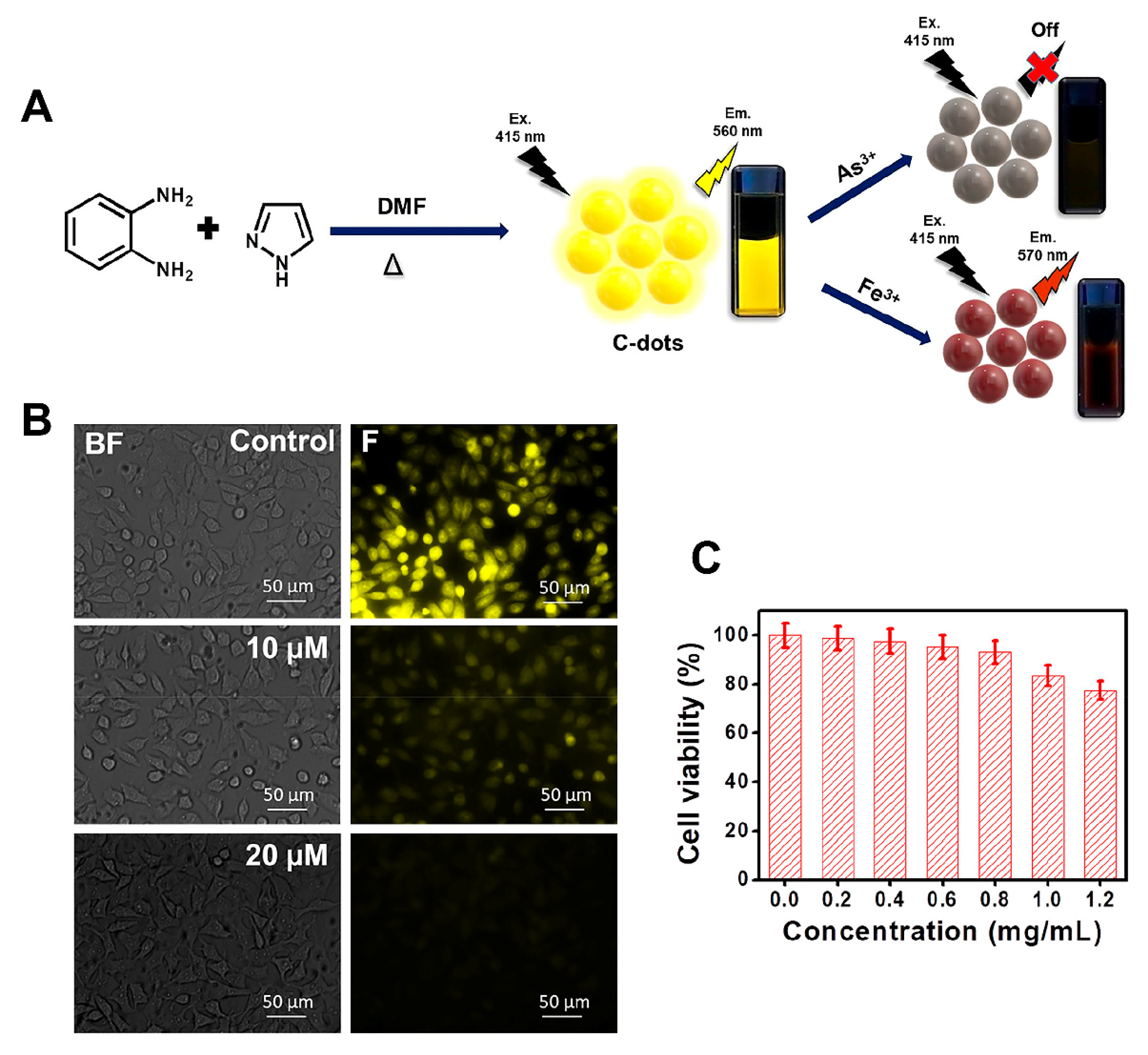
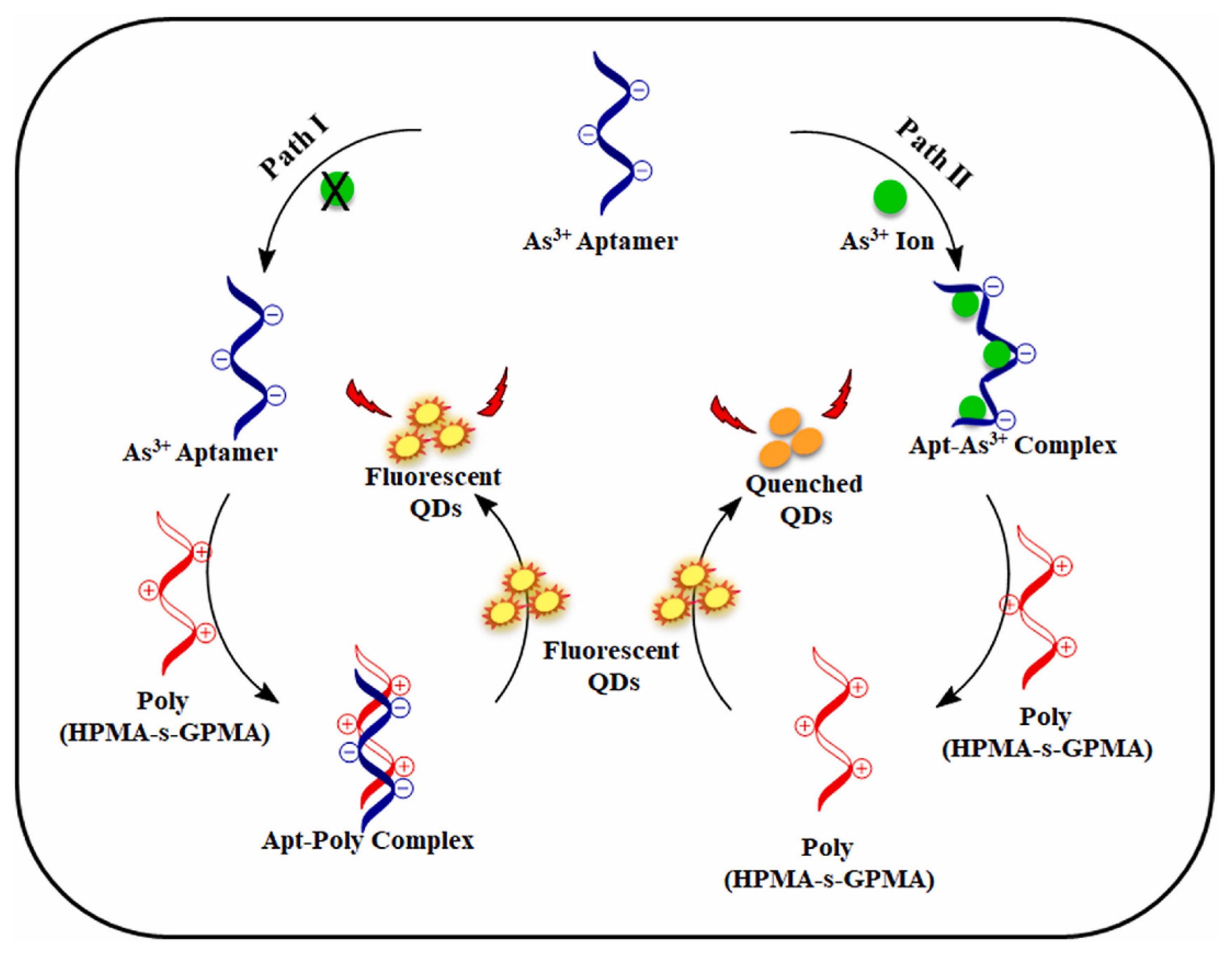
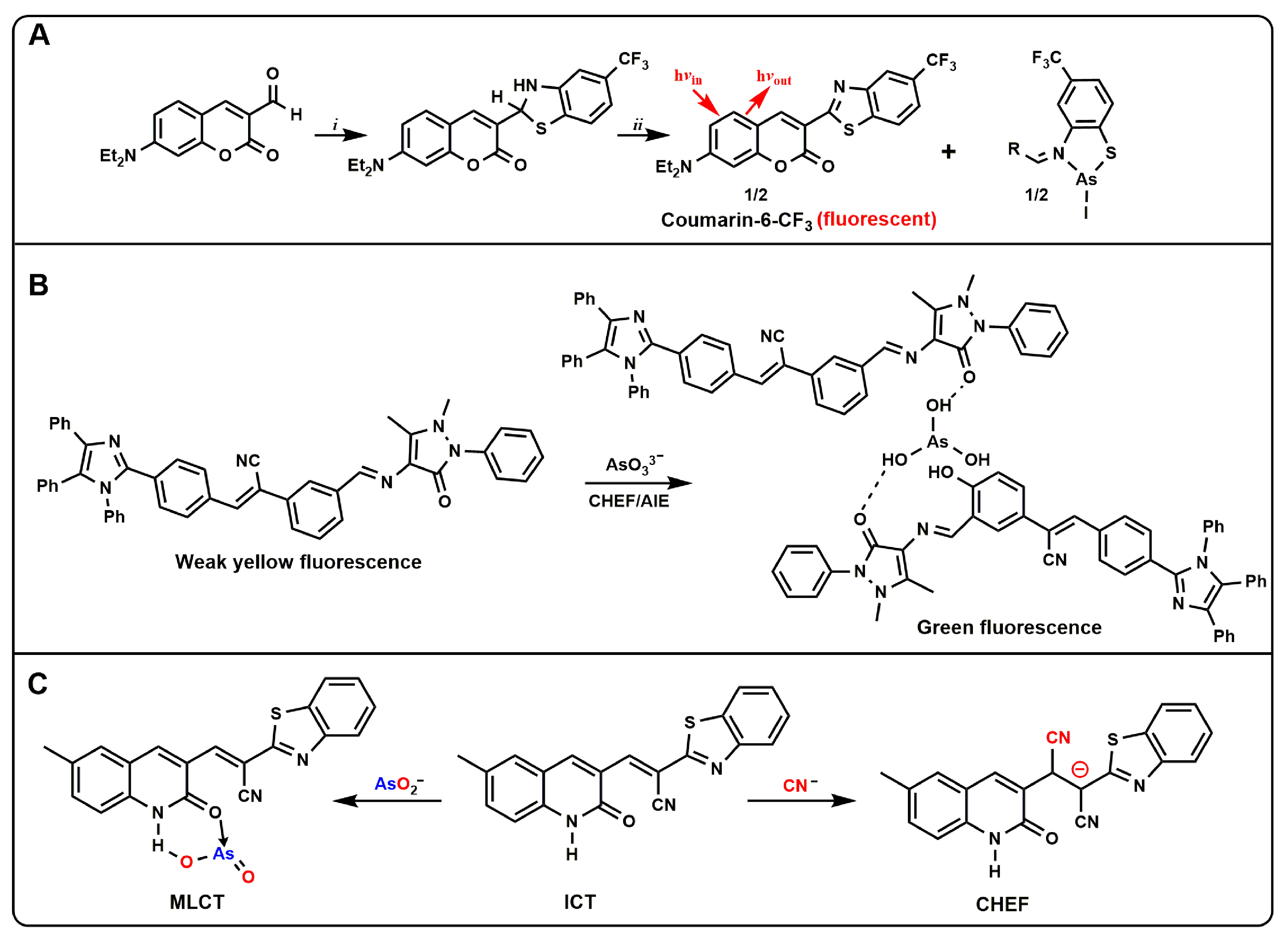


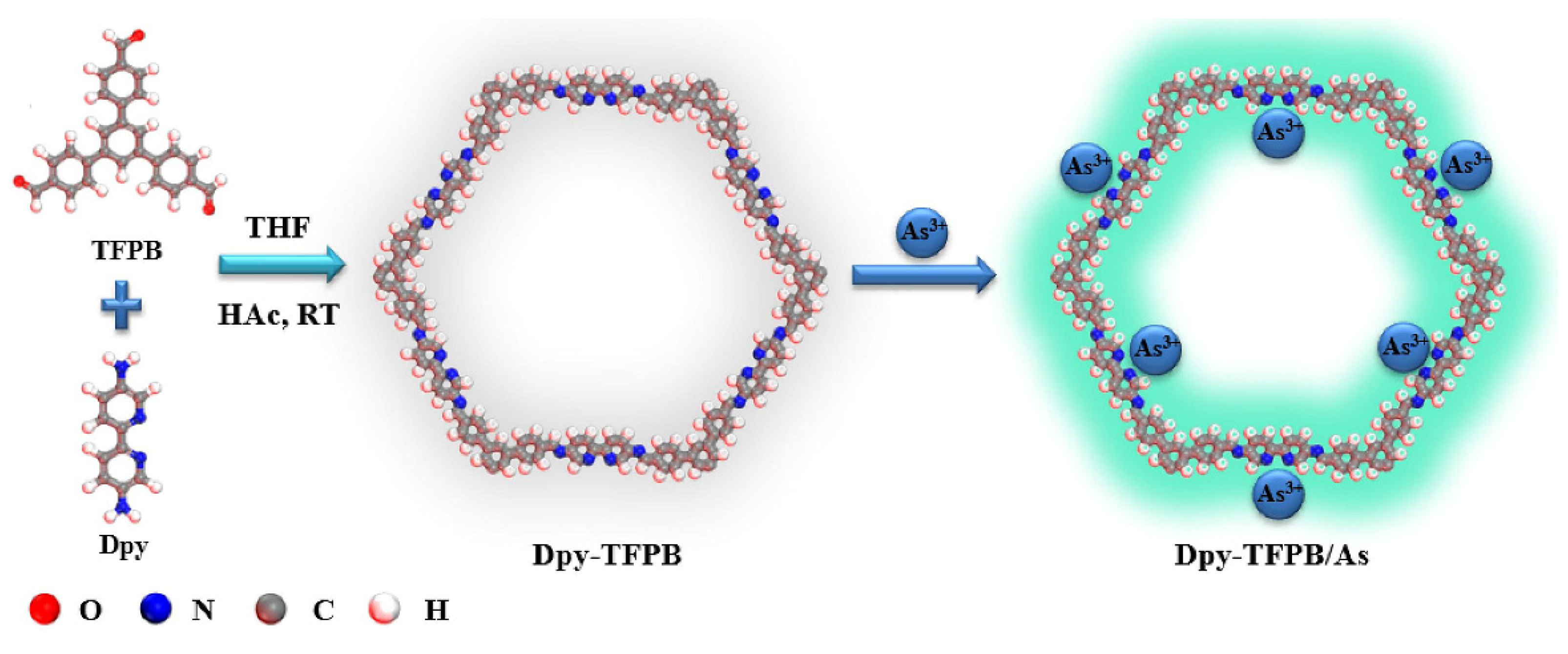
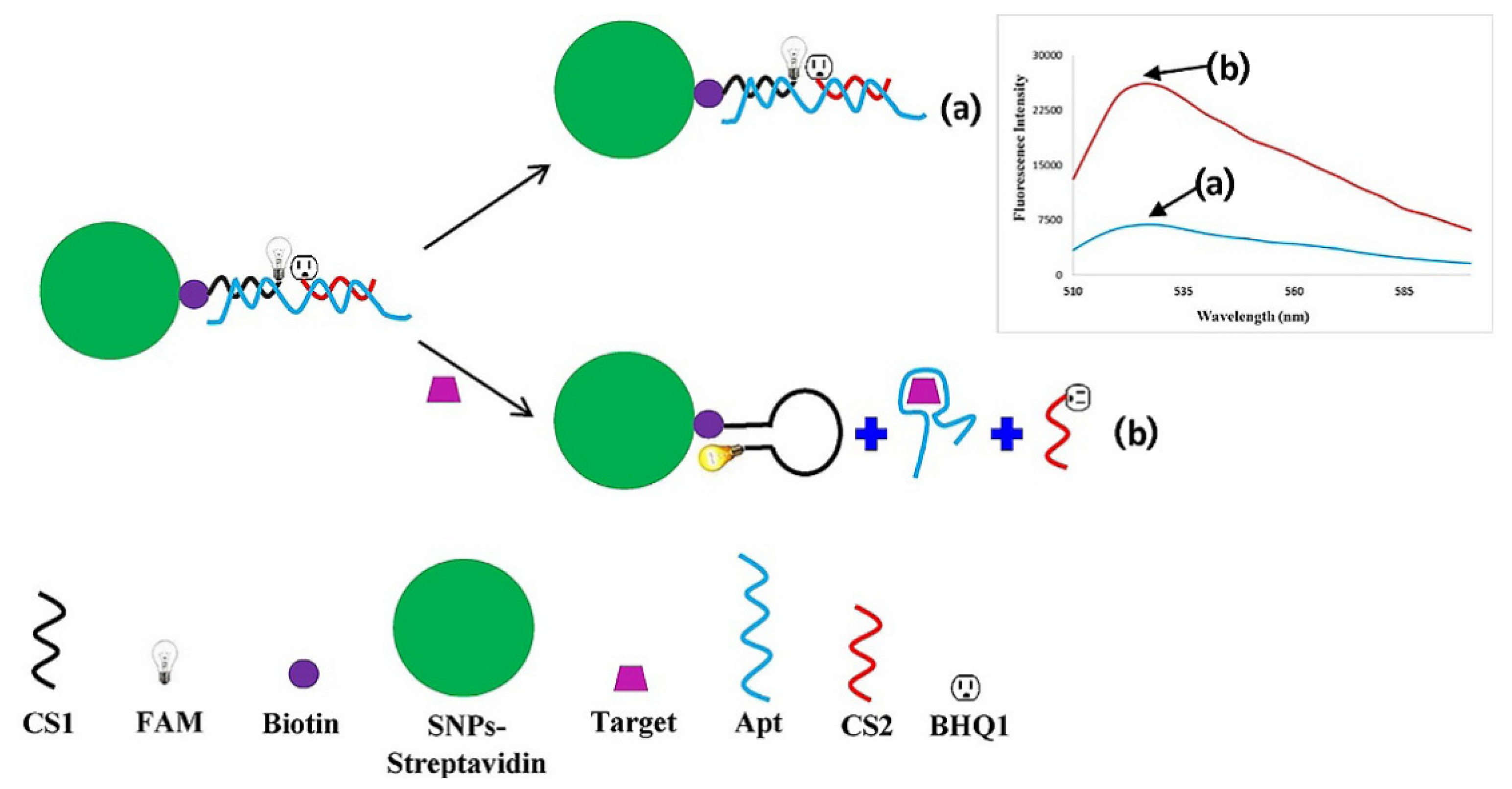
| Detection System | Detection Mode | LOD | Ref. |
|---|---|---|---|
| Cys-Cys modified water-soluble fluorescent gold clusters | Turn-On | 53.7 nM | [24] |
| Carbon-Au-BSA | Turn-Off | 0.05 nM (0.004 ppb) | [25] |
| PLNPs and DTT modified AuNPs | Turn-On | 55 nM | [26] |
| Multicolor fluorescent sulfur doped CDs | Turn-Off | 0.032 nM (32 pM) | [27] |
| GSH-CDs | Turn-Off | 2.3 nM | [28] |
| O-phenylenediamine and pyrazole CDs | Turn-Off | 24.4 nM | [29] |
| Ag-h-CdS/ZnS | Turn-Off | 3 nM (0.226 µg/L) | [30] |
| CdSe/QDs/Tb-GMP | Turn-On | 5.2 nM (0.39 ppb) | [31] |
| MSA-CdTe/QDs | Turn-Off | 214 nM (0.016 mg/L) | [32] |
| MPA-CdTe@CdS/QDs | Turn-Off | 0.24677 nm (246.77 pM) | [33] |
| PbS/QDs | Turn-Off | 49.4 nM (3.7 ppb) | [34] |
| ssDNA-CuInS2 QDs | Turn-On | 0.13 nM | [35] |
| ssDNA-QDs | Turn-On | 1.6 nM (0.2 ppb) | [36] |
| Fe-GQDs | Turn-On | 68 nM (5.1 ppb) | [37] |
| Ce-CPNs | Turn-Off | 9.3 nM (0.7 ppb) | [38] |
| FAM-labeled Ars-3 ssDNA | Turn-On | 18 nM | [39] |
| Cd/Zr-UiO-66 | Turn-Of | 5400 nM (5.4 μM) | [40] |
Publisher’s Note: MDPI stays neutral with regard to jurisdictional claims in published maps and institutional affiliations. |
© 2022 by the authors. Licensee MDPI, Basel, Switzerland. This article is an open access article distributed under the terms and conditions of the Creative Commons Attribution (CC BY) license (https://creativecommons.org/licenses/by/4.0/).
Share and Cite
Qiu, Y.; Yu, S.; Li, L. Research Progress in Fluorescent Probes for Arsenic Species. Molecules 2022, 27, 8497. https://doi.org/10.3390/molecules27238497
Qiu Y, Yu S, Li L. Research Progress in Fluorescent Probes for Arsenic Species. Molecules. 2022; 27(23):8497. https://doi.org/10.3390/molecules27238497
Chicago/Turabian StyleQiu, Yunliang, Shuaibing Yu, and Lianzhi Li. 2022. "Research Progress in Fluorescent Probes for Arsenic Species" Molecules 27, no. 23: 8497. https://doi.org/10.3390/molecules27238497
APA StyleQiu, Y., Yu, S., & Li, L. (2022). Research Progress in Fluorescent Probes for Arsenic Species. Molecules, 27(23), 8497. https://doi.org/10.3390/molecules27238497








